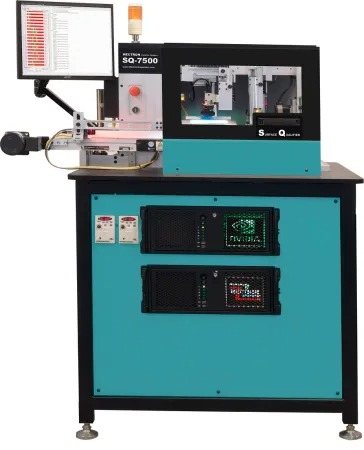Mectron Inspection’s Surface Qualifier 7500 (SQ-7500) is a camera-based system that uses statistical learning to inspect cylindrical parts. The parts traverse the machine by being rolled along an angled rail by a conveyor belt so that the camera obtains 360 degrees of images to fully inspect the part.
 The system is capable of obtaining and analyzing over 100 million data points per second. Using statistical learning the SQ-7500 can analyze each data point in a matter of milliseconds. The camera takes images of the surface of the part at a rate of up to 400 images per second; each image contains 98,850 data points. This speed is possible by using a GPU (Graphics Processing Unit) with over 2,050 cores. GPUs were developed for the video gaming industry and for the graphics displays on video gaming consoles. Since the SQ-7500 uses cameras it was possible for Mecron to adapt the use for inspection at incredibly high speeds. The SQ-7500 uses controlled light reflections and Mectron’s in house developed statistical learning software to detect surface defects.
The system is capable of obtaining and analyzing over 100 million data points per second. Using statistical learning the SQ-7500 can analyze each data point in a matter of milliseconds. The camera takes images of the surface of the part at a rate of up to 400 images per second; each image contains 98,850 data points. This speed is possible by using a GPU (Graphics Processing Unit) with over 2,050 cores. GPUs were developed for the video gaming industry and for the graphics displays on video gaming consoles. Since the SQ-7500 uses cameras it was possible for Mecron to adapt the use for inspection at incredibly high speeds. The SQ-7500 uses controlled light reflections and Mectron’s in house developed statistical learning software to detect surface defects.
The machines first collects data on good parts known as the master set. The Master set tells the software what is considered normal and acceptable for a given part. All parts that are run through the machine are compared to known master parts using Mectron’s new statistical analysis software. The inspection method is based on a comparative test and inspects each received data point to build an overview of the part. Using the master method part-to-part variation can be accounted for while still identifying defects.
The SQ-7500 is a modular system that can have up to three stations. Two camera stations and one eddy current station for crack detection. Eddy current uses a differential probe to make a tight helical scan on the part. The differential probe allows for some lift off and maintains accuracy while the part traverses the machine. The back camera station looks at the rear of the part as it moves along the belt and detects defects as well as reads patterns or characters.
After all stations inspect the part, they either accept or reject based on preset limits. If the part is accepted it will transfer into the rotary gate and be moved into the acceptance chute. If any station sends a reject signal, the rotary gate remains static and the defective part will head straight through to the reject bin. The system uses positive acceptance making it a fail-safe gate.
For more information: www.mectroninspection.com
Tags: 360 Degree Automated Visual Inspection, 3d vina, hiệu chuẩn, hiệu chuẩn thiết bị, máy đo 2d, máy đo 3d, máy đo cmm, sửa máy đo 2d, sửa máy đo 3d, sửa máy đo cmm
